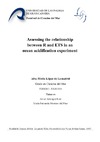Please use this identifier to cite or link to this item:
https://accedacris.ulpgc.es/jspui/handle/10553/74851
| Title: | Assessing the relationship between R and ETS in an ocean acidification experiment | Authors: | Filella López De Lamadrid, Alba | Director: | Arístegui Ruiz, Javier Montero Del Pino, María Fernanda |
UNESCO Clasification: | 251001 Oceanografía biológica | Keywords: | ETS (electron transport system) R (Respiration rates) Ocean acidification |
Issue Date: | 2016 | Project: | KOSMOS 2016 | Abstract: | The ETS (electron transport system) method has been widely applied in aquatic ecosystems to estimate planktonic respiratory activity. As with other enzymatic methods, the ETS represents a proxy of activity, which needs to be transformed to actual respiration rates (R) by means of R/ETS ratios. Paradoxically, few studies have focused on the variability of R/ETS, and most of these were performed with single organisms under culture conditions. Here, we explore, by the first time, the variability of R, ETS and R/ETS of natural microplanktonic communities enclosed inside mesocosms, treated with different CO2 additions. The experiment lasted 30 days, during which the ecosystem underwent abrupt changes in community structure through a transition from oligotrophy to highly eutrophic conditions after nutrient-induced fertilization. R and ETS increased significantly during the phytoplankton bloom period at the two mesocosms with higher CO2 concentrations, coinciding with a rise in diatoms and heterotrophic bacteria cell numbers. However, we did not find any clear relationship between R/ETS and community structure or biomass. R and ETS were weakly, but significantly, correlated considering all the mesocosms. Nevertheless, the R/ETS ratio was highly variable, ranging more than 3 fold in magnitude during the experiment. Average R/ETS (both before and after fertilization) were >1, which is an unexpected result, assuming that ETS represents potential respiration rates. Together with the meagre published literature on the topic, our results suggest that R/ETS may be too variable as to apply constant ratios to different marine communities and environmental conditions. Thus, until we understand the factors driving the R/ETS changes and are able to constrain the range of variability of the ratio we should be cautious when deriving actual respiration from ETS, unless we measure the two variables at the same time during fieldwork experiments and cruises. | Department: | Departamento de Biología | Faculty: | Facultad de Ciencias del Mar | Degree: | Grado en Ciencias del Mar | URI: | https://accedacris.ulpgc.es/handle/10553/74851 |
| Appears in Collections: | Trabajo final de grado |
En el caso de que no encuentre el documento puede ser debido a que el centro o las/os autoras/es no autorizan su publicación. Si tiene verdadero interés en el contenido del mismo, puede dirigirse al director/a o directores/as del trabajo cuyos datos encontrará más arriba.
Show full item recordPage view(s)
67
checked on Dec 30, 2023
Download(s)
71
checked on Dec 30, 2023
Google ScholarTM
Check
Share
Export metadata
Items in accedaCRIS are protected by copyright, with all rights reserved, unless otherwise indicated.
